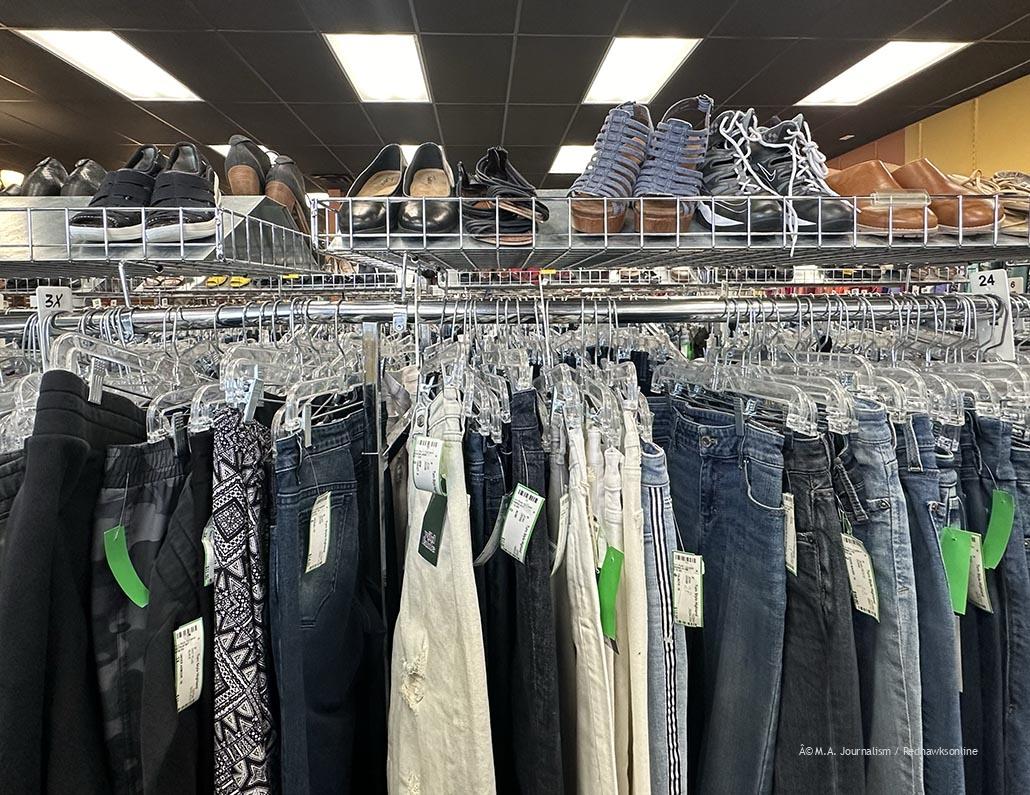Fashion, an ever-evolving phenomenon with never-ending shifts in trends. Clothing goes from cropped to oversized, skinny to baggy, graphic to basic, formal to casual, and back again. But in recent years a more notable shift has gone underway: new to used. Thrifting, the act of purchasing second-hand clothing, has risen in popularity.
Thrifting bids adieu to “fast fashion”, the homogenized mass-production of clothing that dominates mainstream retail today. It has replaced many people’s desire to purchase new clothing which in turn is a shift towards sustainability. The trend has reimagined the fashion space taking clothing that was previously considered old to be vintage and from used to love as well as providing a means to develop a personal style while lingering in the nostalgia of the wardrobes of the past.
There are many reasons why people thrift, including increased product quality and decreased retail price.
“My favorite thing about thrifting is it being so inexpensive,” said junior Langston Stingley. “It being affordable allows me to shop while not paying full price for good quality things.”
Stingley previously worked in a consignment store where she sourced the majority of her second-hand clothing.
“I think a strong teenage desire is buying a lot of clothing,” said Stingley. “One could say that I love shopping. I like buying clothes, and the fact that there’s an option to shop second-hand is a very good thing because then I don’t have to spend as much money for items that are basically new, and I am shopping more sustainably than buying brand new.”
Dora Wagner, one of the Minnehaha Academy Upper School librarians, shares a similar passion for second-hand shopping.
“I love the great quality clothes that you can find and how they’re a little bit unique,” said Wagner. “The fabrics tend to be more durable and the construction is more beautiful and careful. I really appreciate all the little pieces, and I find that they just last and fit really well.”
Another main reason why people thrift is its aspect of sustainability. Fast fashion creates problems like overproduction, resource depletion, and heavy pollution that negatively affect the environment, but according to Goodwill Industries International, the three main benefits of thrifting are less resource consumption, reduced waste, and less chemical pollution. Thrifting acts as a complete reverse of the regular clothing market but is more limiting for consumers.
“It requires a bit more care and intentionality,” said Wagner. “Not everything is available in all sizes for unlimited consumption.”
Thrifting prompts people to be more intentional with their purchases yet it can highlight problems with availability, but that can be seen as both a positive and negative thing. On one hand, there may be inconvenience for some shoppers because of the limited pieces, but on the other hand, it hinders unnecessary consumption. If thrifting is impeding shoppers from being able to find clothing that works for them, it is not necessarily bad to purchase new. Purchasing new is not always negative because there are some sustainable options for buying retail.
Greenwashing is “the act or practice of making a product, policy, activity, etc. appear to be more environmentally friendly or less environmentally damaging than it really is,” according to the Merriam-Webster Dictionary.
Many clothing stores and brands greenwash their products to make them seem sustainable while they are not. They do this with slogans, fonts, colors, and themes that appeal to the environment. Like blue, green, and brown advertisements to insinuate the outdoors. It makes shoppers more inclined to shop sustainably to find interest in their products, while the companies do not have to change their unsustainable practices at all.
If it is feasible for the consumer to, there are some genuinely sustainable brands that they can acquire pieces. Shopping sustainably while purchasing new tends to be more expensive but it boils down to what the buyer truly wants and needs.
“If you can’t spend $300 on a pair of jeans it’s about asking yourself, how many pairs of jeans do I need?” said Wagner. “Can I purchase one pair of jeans and wear them 20-30 times a year? Can I wear them three times a week and not have a problem with it?”
Instead of buying 10 pairs of jeans for $30 or five shirts for $100, consumers can take the more sustainable approach and purchase fewer items.
Shopping sustainably frankly boils down to acquiring clothing with quality over quantity in mind. Taking the time and being intentional with what one purchases, equips one with a more sustainable way to acquire clothing that will be well-loved.
“Clothing is fun,” said Wagner. “It’s lovely to dress in a way that you feel like expresses yourself. But to do so we want to be more than consumers.”

